Breath-taking Adventure: Big Island Hike to Pololu Valley Reveals Nature’s Majestic Beauty
A gorgeous hike from the top to the gorgeous black sandy beaches of Pololu Valley, the drive alone and panoramic views of the cliffs and coastlines impresses the moment you park on the end of road.
This is a relatively short hike to the bottom and nice to explore the slowly rambling stream that ends at the ocean or just amble from one end of the black sand beach to the cliffs on the other side and maybe do a climb to another gorge beyond if you feel challenged to do more exploring. Check out all the fun details of this Big Island hike to Pololu Valley.
Quick Plan your West side Big Island Itinerary
Are you in a rush on a last-minute trip to visit the West Side, Big Island? Well then, try our jump start guide to book the best tours and hotels below.
Pro Tip – Since you are planning to visit take this Full circle island tour and enjoy fantastic views along your BIg Island tour
Top Tours to Try in the West side
Volcanoes Naional Park tour – Day Trip Tour
Private Helicopter tour– Top Rated
Manta Ray Dive – Easy tour classes
Where to Stay in around the West Siden
Hilton Waikoloa Village – Family Friendly in Waikoloa Village
Fairmont Orchid – Kohala Coast Resort
Mauna Lani Auberg resort– Kona Resort
How to get to Pololu Valley
Pololu Valley is an easy drive from Highway 270 through idyllic towns like Hawaii and Kapa’au. After you pass mile marker 28, you’ll get some peak a boo views to the cliffs of Pololu. Make sure you find parking even from a distant walk to the entrance of the trail since parking is limited right at the entrance.
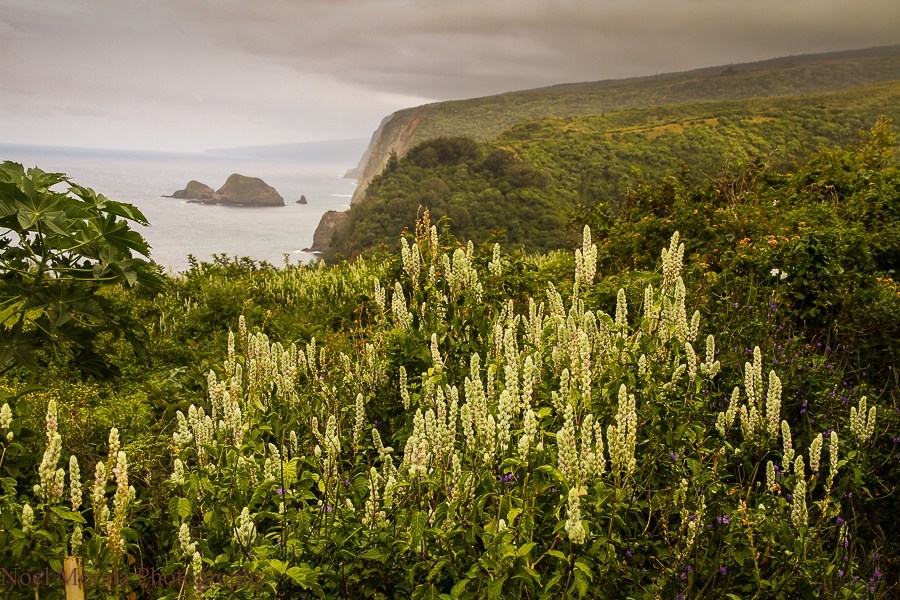
History of Pololu Valley
Pololu Valley was formed over 250,000 to 300,000 years ago when the Kohala Volcano experienced a huge collapse and landslide with a large part falling into the ocean and creating this massive gulch and valley that we see today.
Located on the northeastern coast of Hawaiʻi Island in the North Kohala region, the area holds deep cultural, historical, and geological significance in Hawaiian history. Once a thriving center for traditional agriculture and native life, Pololū’s story reflects the broader transformation of Hawaiʻi from pre-contact society through colonization and into modern times.
Early Native Hawaiian Significance
Pololū Valley was traditionally inhabited by Native Hawaiians who practiced lo‘i kalo (taro farming) and subsistence fishing. The valley’s freshwater stream and fertile soil supported a sustainable community that lived closely with the land (‘āina). The layout of the valley included taro terraces, irrigation channels (‘auwai), and forest resources, showcasing advanced agricultural techniques.
Pololū is one of a series of steep, deep valleys on the windward Kohala coast that were formed by erosion from the ancient Kohala volcano. These valleys were prime areas for early Hawaiian settlement because of their access to fresh water, shelter from trade winds, and abundant natural resources.
Decline and Depopulation
Following Western contact in the late 18th century, significant changes affected Pololū and surrounding valleys. Introduction of diseases, land tenure changes under the Great Māhele (1848), and shifts in the economy led to population decline. As sugar plantations expanded across the island, many residents left subsistence farming for wage labor. By the early 20th century, Pololū Valley had been largely abandoned as a residential area.
20th Century Use and Modern Access
In the 1900s, small-scale ranching and intermittent farming took place in Pololū, but it never regained its former population. The valley eventually became known more for its scenic beauty and hiking access. The Pololū Trail leads down a steep but accessible path to the valley floor, offering views of the black sand beach and dramatic sea cliffs. The area remains largely undeveloped and is considered sacred by many Native Hawaiians.
Cultural and Environmental Considerations Today
Today, Pololū Valley is part of an ongoing conversation about stewardship and indigenous rights. Local groups are advocating for culturally sensitive access, land protection, and restoration of native agricultural practices. Visitors are encouraged to approach the valley with respect and to understand its historical and spiritual importance to the Hawaiian people.
Citations and References
- Kameʻeleihiwa, Lilikalā. Native Land and Foreign Desires: Pehea Lā E Pono Ai? Bishop Museum Press, 1992.
- Maly, Kepā and Maly, Onaona. He Wahi Mo‘olelo No Nā Loko I‘a o Kohala – A Cultural Assessment of Fishponds and Land Use in Kohala. Kumu Pono Associates, 2003.
- Handy, E.S. Craighill, and Elizabeth Green Handy. Native Planters in Old Hawaii: Their Life, Lore, and Environment. Bishop Museum Press, 1972.
- Hawai‘i State Historic Preservation Division. “North Kohala Historic Context Study,” 2006.
- Office of Hawaiian Affairs. “Pololū Lookout Stewardship Pilot Project.” OHA.org
- National Park Service. “A Study of Cultural Sites in Kohala,” U.S. Department of the Interior, 1999.
Pololu Valley Weather
The weather at Pololu Valley is variable from cloudy and windy to stormy clouds and rain and then to blue sky, and you can even get all three happening on the same day. Best bet is to check the daily weather patterns for the day and see if it works with your plans to visit for the area.
The best time to visit Pololu Valley is during the dry season, which typically occurs from May to October. During this period, you can expect warm temperatures, clear skies, and minimal rainfall. It’s an ideal time for hiking, taking in the stunning vistas, and enjoying the beach.
In contrast, the wet season in Pololu Valley runs from November to April. Although rain showers are more frequent during this time, they often come and go quickly, allowing for occasional sunny breaks. The lush greenery and flowing waterfalls make the valley particularly picturesque during this season.
It’s worth noting that Pololu Valley’s weather can be unpredictable, and sudden rain showers can occur regardless of the season. Therefore, it’s advisable to come prepared with appropriate rain gear and check the local weather forecast before embarking on any outdoor activities.

Pololu Valley scenic overlook
Not only is Pololu Valley scenic as an overlook at the end of road, but the hike and views going downhill, the walk across the gorgeous black sand beach is a wonderful experience. If you feel challenged, you can even go beyond to the other valleys beyond Pololu on a day trip or overnight stay.
Or, if your not up to the challenge, the overlook area above the valley is quite spectacular. You can also see the other gulches in the distance from above.
Hiking down to Pololu Valley floor
The hike down is mostly gravel and soil and relatively easy to climb down depending on temperature and wetness factor. You should hike down with sturdy shoes or boots for the variable rocks, steps and slope factor. The roundtrip hike goes down about 420 feet to the valley floor and is only about a half hour hike to the bottom of this .6-mile hike. It’s a relatively easy 30-minute hike down to the floor and then to the black sand beach which you can hike from end to end.
Most of the trail is dirt and gravel path, so take your time when going through and there are scenic overlook spots along the way to enjoy the views and capture the moment.
It is wide enough for both uphill and downhill traffic to the bottom but give some clearance to people struggling uphill.
The seven gulches of the Kohala gulches
Pololu valley is one of the gulches at the tail end of gulches that were formed with the erosion of the Kohala Volcano. The rest of the gulches follow in order from:
- Pololu Valley
2. Honokāne Nui
3. Honokāne Iki
4. Honoke’a
5. Honopue
6. Waimanu Valley
7. Waipi’o Valley
Most visitors that hike down to Polulu make it to the main valley floor with a few that try to make it to the next overlook at Honokane Nui and down to the valley floor.

Parking situation at Pololu lookout point
Parking is just at the end of road with most day trippers coming to take pictures and leave, so there is a lot of turnovers for the parking spots. You can also park further out and then walk to the end where the trail begins.
Patience is key or come either in the early mornings or late afternoon timeframe when parking is easier to get a spot.
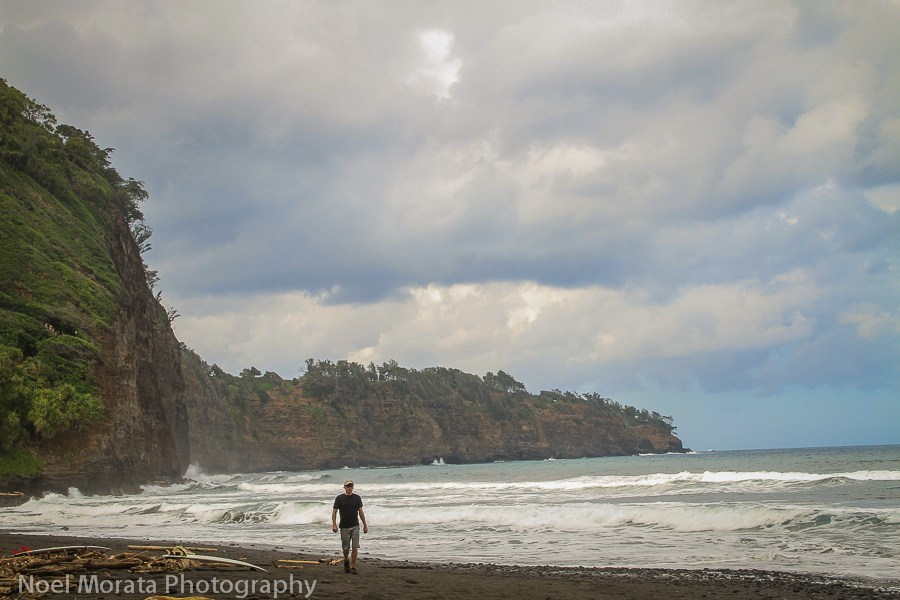
The black sand beach of Pololu
Once you get to the bottom, head for the black sandy beach (the small trails that follow the stream inland ends and is mostly private lands that are off limits to explore. Views of the beach with the impressive 500 foot cliffs make for a fantastic photo opportunity in the area.
The expansive black sand beach is fantastic to walk through and check out the rock sculptures and enjoy the beach. There are no lifeguards on the beach and the surf breaks and the beach with undertow is treacherous so swimming is not encouraged on the beach. It is not considered a swimming beach and sometimes inundated with Portuguese man-o-wars, so do not try to swim this dangerous beach especially with no resources for helping in drowning conditions.
There is a trail that leads through the canyon gulch at a distance but visitors are not allowed to pass beyond a certain area since it is private lands. There are are group tours that lead visitors directly to see the waterfall at Pololu called Kapoloa Falls, this is managed by Hawaii Forest and Trail.
Is camping allowed at Pololu?
Most people visit just day camp on the valley floor into the late hours. Camping is not allowed at Pololu since it is on private land and permits only issued for specific research studies.

Along the riverbank are tall ironwood trees with swings set up for some casual fun and really high swinging.
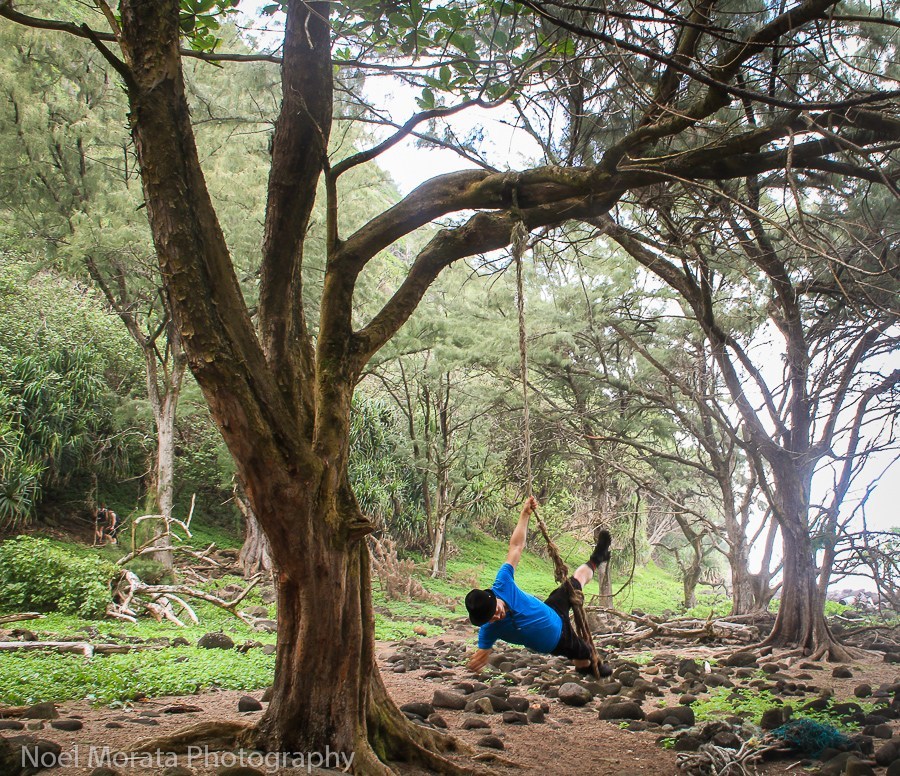
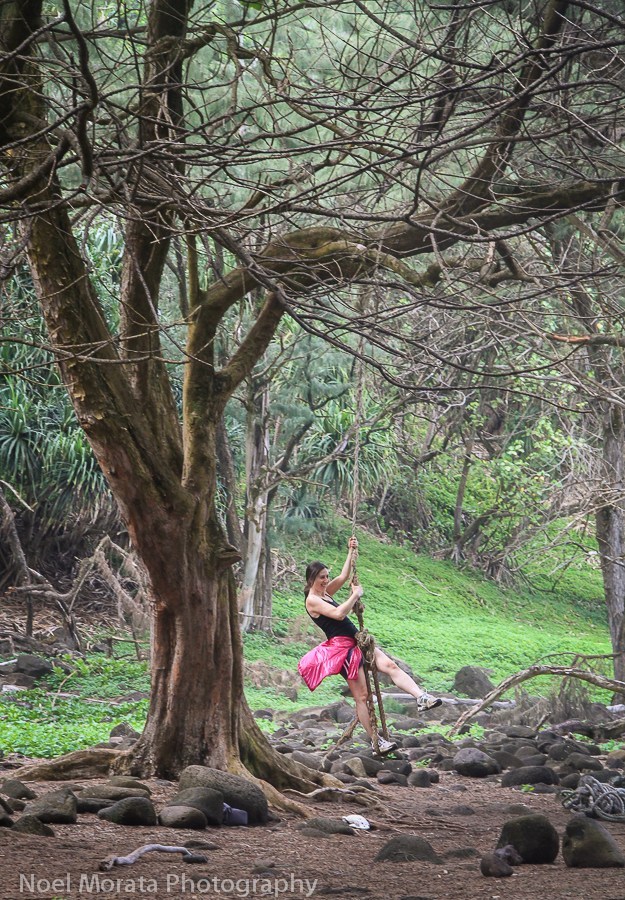
You can take a short stroll along the riverbank before it stops with warning signs of private property beyond the trail areas.

Beyond Pololu and hiking to Honokane Nui trail
If you’re challenged to extend your hike, consider going beyond to the next valley on the Honokane Nui trail to reach the Honokane gulch. The trail is located about a hundred feet from the shoreline with a small trail located with low lying ferns and on the eastern ridge of Polulu.
You climb over 750 feet with many switch backs for about one mile uphill. You’ll finally get to a high ridge with magnificent views of Honokane and the other cliffs of the Kohala mountains. Someone generously placed a new bench which conveniently turns into a table and seating area with magnificent views down the Honokane Nui.
If you choose to hike down, the trail has been fixed is a challenging going through two sets of ropes for rappeling down a mostly dirt and rock area, a gorgeous walk through native fan palms and surprising a stunning natural bamboo grove.
There are no trails heading out to the rocky beach areas but you can walk down through an old Hawaiian village and area of rock walls and pond enclosures that were probably made for growing taro, keeping animals and shelter which is truly amazing to visit. (Please do not disturb anything in this ancient site – it is untouched and still in wonderful condition).
As you get to the beach areas there is a variety of camp sites and abandoned sites with refused from ocean findings that probably washed onshore. If you can find the river area on the far right, there is a small pond area that is relatively safe for swimming in depending on the water levels and weather.
HIke to Honokane Iki Gulch
The third guich is higher in elevation and some of the trail is very tricky with barely any trail walking the sides of loose slope but with some helpful ropes to keep you from sliding down hill.
The views from the ridge are stunning into Honokane Iki and the trail leading downhill is relatively easy but note that the property on the valley floor is entirely private property, and access is not permitted (unless you know the owner) on the valley floor unless you can find the trail beyond which is not feasible at the moment because of overgrown conditions. Visiting here is not advised especially with the up and down trekking efforts to get back to the parking area.
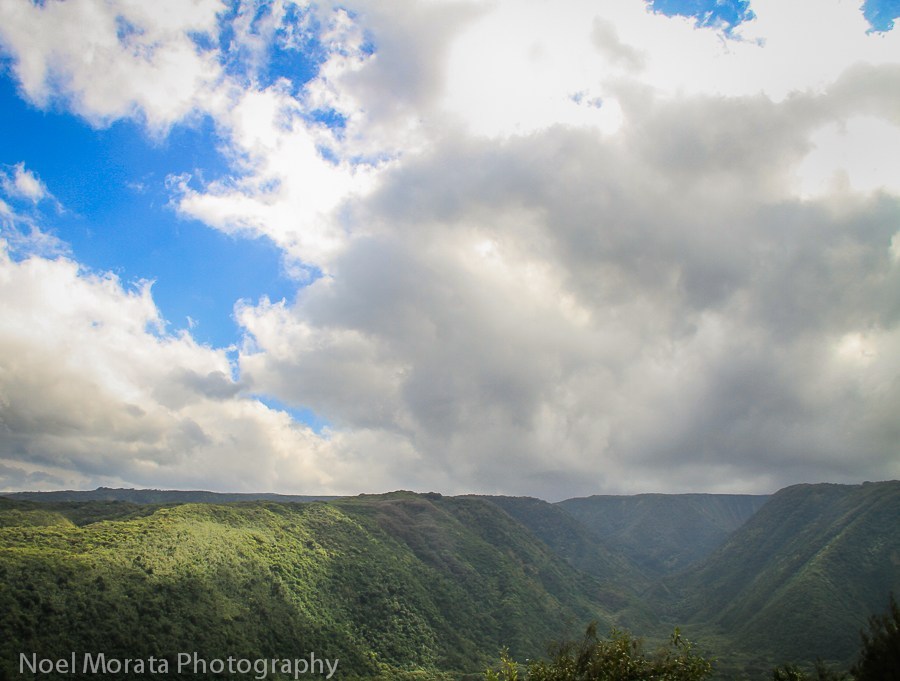
Safety advisory visit Pololu Valley
The trail is steep with 13 percent grade going down to the valley floor and is only .6 miles to reach the bottom.
Start Early: Plan to arrive at Pololu Valley early in the day to avoid crowds and make the most of your time there. The morning hours often offer serene and uncrowded conditions, allowing you to enjoy the tranquility of the valley.
On rainy days, it is muddy and extremely slippery
Respect Nature and Wildlife: Pololu Valley is a pristine natural environment, so it’s important to respect and preserve its beauty. Stay on designated trails, avoid littering, and refrain from disturbing the wildlife. By practicing responsible tourism, you contribute to the preservation of this magnificent place.
Look to visit on sunnier days when the trail is dry and easy to hike below
Prepare for Changing Weather: Even during the dry season, weather conditions in Pololu Valley can change rapidly. It’s advisable to bring a light rain jacket or poncho in case of unexpected rain showers. Additionally, wearing layers allows you to adjust your clothing according to temperature fluctuations throughout the day.
There are no public services or lifeguards at the beach
Bring plenty of water with you on the short hike and sun screen for hot days
The trail downhill is rocky and rough in many patches, so hiking shoes or tennis shoes are necessary to make the hike comfortable and safe.
Enjoy the Beach: After hiking down to Pololu Valley, take some time to relax on the beautiful black sand beach. Listen to the soothing sounds of the ocean, take a refreshing swim if conditions permit, or simply bask in the natural splendor surrounding you.
Conditions on the beach and entry is difficult only enter on calm and safe swimming but not recommended.
Pack and take out what you bring in with you.
There are no amenities and bathrooms down at the valley floor.
Other things to do in the Kohala area
If you are out exploring the Kohala or west side of Hawaii, consider these other places or attractions to visit in the area.
If you’re done with your hiking adventure, check out all these other fun things to explore and see in the area.
Keokea Beach park – a beautiful park with nice views of the coastline with picnic grounds and public services.
ATV tours in Kohala – ATV outfitters take you on tours on private lands for 1.5 to 3-hour scenic tours and outdoor ATV experiences between Hawi and Polulu. Check out the details here for more images and inspiration to doing this tour.
Check out the Kamehameha statue in Kapaau – at the Kohala civic center sits the original statue of Kamehameha 1st who united all of the Hawaiian Islands. You can find more details about the original Kamehameha statue here for more information. The small town of Kapaau has many unique galleries and shops worth exploring while you are in the area.
Explore the western town of Hawi and try some local food and snacks. Also, home to some unique art galleries, boutiques and restaurants located in old plantation style buildings, you can easily spend a few hours exploring and eating your way through town.

Directions to Pololu Valley
Drive down the Akone Pule highway 270 and past the small town of Hawi. From there its another 8 miles until you hit the end at the Pololu Valley Look out point.
Find a parking spot and walk to the end of the overlook area and you can decide if you want to hike the brief downhill trail to the valley floor.
Pin this for later
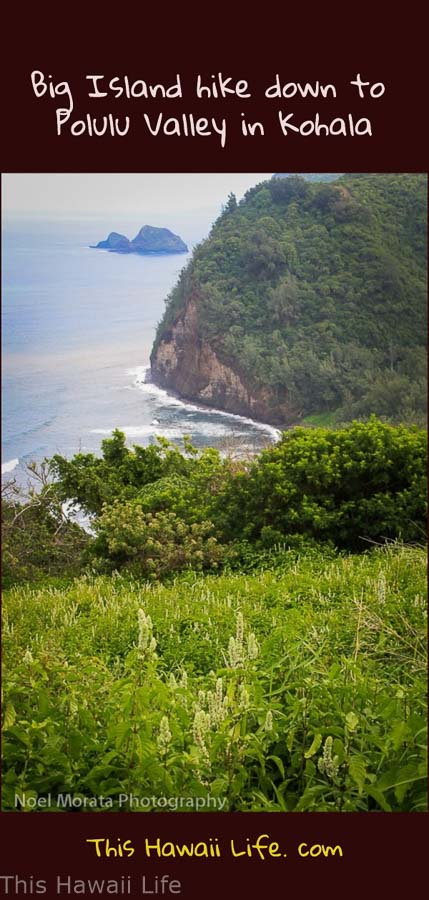
Check out these other fun hikes on the Big Island of Hawaii
Hiking the Green sand beach at Papakolea
Big Island Hike at Pu’uwa’awa’a
Big Island Hike to Ha’ena/Shipman Beach
Conclusion to a Big Island hike to Pololu Valley
Doing a on a Big Island hike to Pololu Valley is an extraordinary experience that unveils the raw beauty of Hawaii’s hidden gem. From the moment you set foot at the overlook and then head out on the trail. You are greeted by lush landscapes, dramatic cliffs, and the soothing sounds of nature. As you make your way down to the valley, the captivating vistas and the black sand beach captivate your senses, offering a serene escape from the bustling world. Whether you choose to visit during the dry season for clear skies or venture during the wet season to witness the valley’s vibrant greenery, Pololu Valley never fails to leave a lasting impression.
Thanks for visiting today and checking out this post on this Big Island hike to Pololu Valley I hope you are inspired to plan a visit and enjoy these wonderful attractions. If you enjoyed the images and post, could you please share it with any of the social media buttons located around the post.
I want to hear from you!
If you enjoyed the post, please do share it with any of the social media buttons on the left side of the page.
Thanks for visiting This Hawaii life and checking out this post on a Big Island hike to Pololu Valley.
Disclosure – some of the links above are to affiliate sites that are either reviews or recommendations when you book on this site, it helps to keep our site running. We appreciate your supporting our website meanwhile
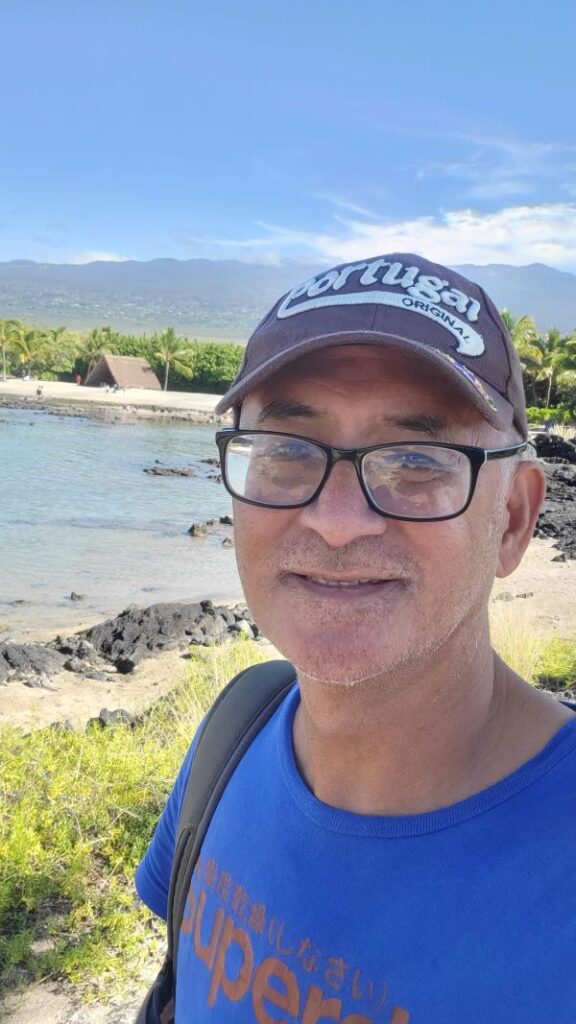
Author Bio – Noel Morata
Having lived in Hawaii for over 15 years, I’ve explore all the historic and cultural sites, tried delicious traditional food, fusion and local style dishes and learned a lot about growing and sustainability.
Hawaii for me is ever changing and I visit many of these places regularly for inspiration, changes that may occur, seasonality and cultural practises. I hope to share with you all the fascinating things and places I’ve learned grown appreciation for and hope that you will find the information helpful to visiting the islands.
I love the black sand beach at Pololu Valley and overlook area, it’s a great place I love revisiting with friends and family to explore this stunning Valley along the Kohala coastline.


I think the admin of this web page is genuinely working hard in support of his website, for the reason that here every material is quality based material.